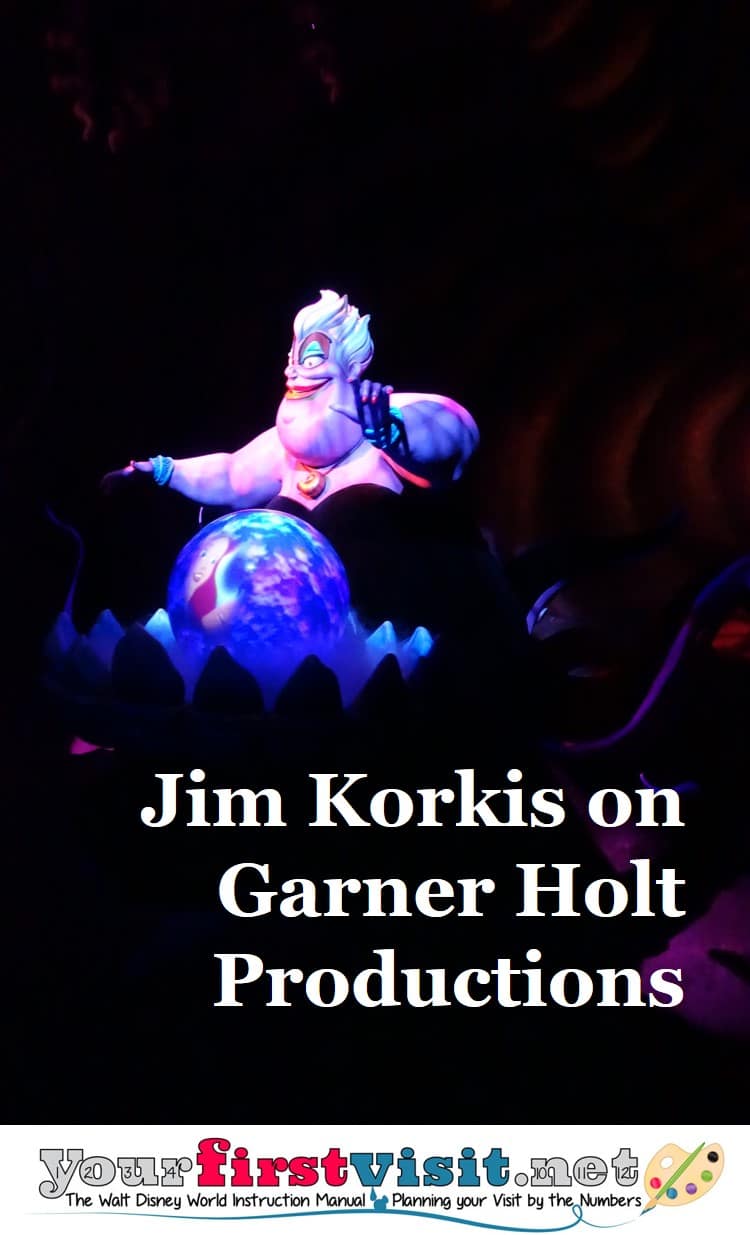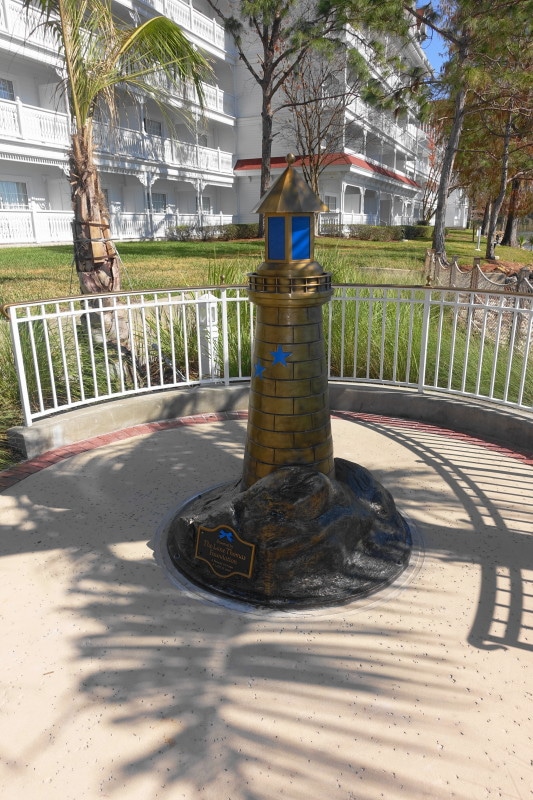Category — A Friday Visit with Jim Korkis
A Friday Visit with Jim Korkis: Your Disney Library (3)
Welcome back to Fridays with Jim Korkis! Jim, the dean of Disney historians, writes about Walt Disney World history every Friday on yourfirstvisit.net.
YOUR DISNEY LIBRARY: THE WALT DISNEY WORLD THAT NEVER WAS
By Jim Korkis
- The Walt Disney World That Never Was: Stories Behind the Amazing Imagineering Dreams That Never Came True by Christopher E. Smith
I have always had a fascination with Walt Disney World projects that were announced, often with elaborate concept art and detailed descriptions, but for a variety of reasons, usually financial, were never built. Since Walt Disney World is so huge, it has been the home to many such abandoned concepts over the decades.
In 2010, Walt Disney World fans were teased with the prospects of Hyperion Wharf, “a nostalgic yet modern take on an early 20th century port city and amusement pier” that at night would be an “electrical wonderland”, taking over the old Disney Springs Pleasure Island location, and also a new Fantasyland concept at the Magic Kingdom presented at the D23 Expo in 2009 that would have had a variety of elaborate Disney Princess meet-and-greet opportunities located within individual princess cottages, including ones for Cinderella and Briar Rose (Sleeping Beauty). Also included in that proposal was a large Disney Fairies area dubbed Pixie Hollow to be completed as the expansion’s last phase.
Neither of those Imagineering dreams appear in The Walt Disney World That Never Was, but they are indicative of how many similar proposals have been presented during the nearly half century since WDW has been open that Smith has been able to find more than enough interesting stories to fill roughly 170 pages of text.
Those stories include background information on Thunder Mesa, Fire Mountain, never-built World Showcase pavilions, David Copperfield’s Magic Underground, Beastly Kingdom, Buffalo Junction and many more.
When he published The Walt Disney World That Never Was, author Christopher E. Smith didn’t have any previous credentials in the world of Disney history, although he now writes articles for Celebrations magazine, a hidden treasure of a slick full-color magazine that focuses on WDW published by Tim Foster that just released its 57th issue. (Copies of that magazine should be in your personal Disney library as well. https://www.celebrationspress.com/)
Smith is a lawyer in Alabama. He first visited Walt Disney World in 1984 at the age of seven and was so enchanted by the place that he returned dozens of times over the next thirty some years.
Unlike someone who personally interviewed Imagineers or had access to proprietary material, Smith’s scholarship comes from previously existing printed sources including Disney Annual reports. He does owe a debt to those pioneering writers who earlier explored these topics in depth. However, it is nice to have all of this information, even if it is sometimes incomplete, compiled in one place.
The book is divided into the following sections: Magic Kingdom, Epcot, Disney’s Hollywood Studios, Disney’s Animal Kingdom and Resorts. Each section has three to five chapters written in a breezy, anecdotal style so that the reader gets a nice sense of what the project might have been and why it was never pursued. In addition, at the end of some chapters are descriptions of some elements that might be found today that were inspired by these plans that were cast aside.
I think that most WDW fans, both those with some knowledge of these stories and especially those with none at all, will be intrigued by what “might have been” at the world’s premiere vacation destination. Like most Theme Park Press books, there are no visuals because of both financial and Disney approval reasons but a diligent reader with the information provided in the text should be able to locate plenty of artwork easily on an internet search.
I do recommend you including this book in your personal Disney library even if it doesn’t necessarily bring any new information or new perspective to this material because for many of you, it will be your first time ever hearing about these things.
* * * * *
Thanks, Jim! And come back next Friday for more from Jim Korkis!
In the meantime, check out his books, including his latest, Call Me Walt, and his Secret Stories of Walt Disney World: Things You Never You Never Knew, which reprints much material first written for this site, all published by Theme Park Press.
Follow yourfirstvisit.net on Facebook or Twitter or Pinterest!!
February 23, 2018 No Comments
A Friday Visit with Jim Korkis: The Leapfrog Fountain at Epcot
Welcome back to Fridays with Jim Korkis! Jim, the dean of Disney historians, writes about Walt Disney World history every Friday on yourfirstvisit.net.
THE LEAPFROG FOUNTAIN IN THE IMAGINATION PAVILION AT EPCOT
By Jim Korkis
Kodak, the original sponsor of the Imagination Pavilion at Epcot, intended the area outside the pavilion to be known as Imagination Gardens, and feature interactive items. The only thing ever built as part of that project was the laminar flow fountains, more commonly referred to as the Leapfrog Fountains.
They were the creation of Mark Fuller, who later went on to found the famous WET (Water Entertainment Technology) Design company with two other ex-Imagineers, Melanie Simon and Alan Robinson, and be responsible for world famous water experiences like the Fountains at Bellagio for the hotel and casino in Las Vegas.
Fuller’s first job after getting a master’s degree in mechanical engineering at Stanford in 1978 was to create something new and exciting for the upcoming opening of Epcot Center. For the Epcot project, Fuller worked with Bill Novey.
Fuller had spent six years trying to get an interview with Imagineering and eventually succeeded in being interviewed by the legendary Imagineer Wathel Rogers, who was impressed by Fuller’s portfolio of work.
“The one thing I think we recognized right away was that Mark was willing to take a chance,” recalls Marty Sklar, former president of Walt Disney Imagineering. “He wasn’t afraid of trying something nobody else had done before.”
In his studies at Stanford, Fuller had experimented with laminar flow technology, so he was already very skilled in making a perfect tube of water. Fuller had already built the world’s first permanent laminar fountain in Salt Lake City as part of his thesis and had won an award for it from the American Institute of Architects.
Unlike water flowing from a household faucet where molecules bounce haphazardly around in different directions, in laminar flow, the molecules are channeled in one direction under equal, steady pressure. The stream of water that is produced by laminar flow can appear stationary or solid, like a clear tube, from a distance.
Fuller, working with other WDI staff including Tony Baxter, engineered a way to make the water jump and turn on and off, using laminar flow with added valves and programming so it looked like the water was randomly leaping from basin to basin.
The challenges included making the streams high enough and far enough apart for people to pass underneath them and to control the water splash when the stream landed.
Ironically for an attraction that has delighted guests of all ages for over three decades, Disney leadership was not initially impressed with the idea, but show producer Barry Braverman decided to take a chance since Kodak was adamant that they wanted the area to have a whimsical personality.
Fuller’s approach seemed to transform ordinary water into a living character much like in classic Disney animation.
Fuller also designed other water experiences at Epcot Center including the “upside down” waterfall near the pavilion and the “popjet” fountains that would unexpectedly spout up streams of water from the pavement.
After working for Imagineering for five years, Fuller left to establish his own company since he felt constrained on what he envisioned he might be able to accomplish with water.
In March 2010, Fuller was presented with the Themed Entertainment Association Lifetime Achievement Award, and while he has not been an Imagineer for decades, his work for Epcot still continues to enchant and amuse with the same sense of wonder as when it first opened.
* * * * *
Thanks, Jim! And come back next Friday for more from Jim Korkis!
In the meantime, check out his books, including his latest, Call Me Walt, and his Secret Stories of Walt Disney World: Things You Never You Never Knew, which reprints much material first written for this site, all published by Theme Park Press.
Follow yourfirstvisit.net on Facebook or Twitter or Pinterest!!
February 16, 2018 1 Comment
A Friday Visit with Jim Korkis: Garner Holt Productions
Welcome back to Fridays with Jim Korkis! Jim, the dean of Disney historians, writes about Walt Disney World history every Friday on yourfirstvisit.net.
GARNER HOLT PRODUCTIONS
By Jim Korkis
In 2012, Garner Holt Productions in San Bernardino, California acquired the complete Disney animatronics parts inventory dating back more than forty years. The 500,000-part former MAPO inventory included components from Pirates of the Caribbean, Haunted Mansion, Great Moments with Mr. Lincoln and the Carousel of Progress. That means Garner Holt Productions now serves as the replacement parts lead for Disney audio-animatronics.
Garner Holt and his company was granted this unique honor because of its outstanding work on Disney theme park attractions as well as its commitment to innovation in building some of the most sophisticated animatronics figures ever created.

The forty-five foot tall Maleficient dragon in the finale for Disneyland’s Fantasmic! Nighttime show is the work of GHP.
“There were a few delays” creating that, Holt said. “You’re talking about arguably the largest and most complex figure ever built.”
In 1973 at the age of twelve, Holt visited Disneyland and decided he wanted to be an Imagineer. His racehorse-trainer father wanted him to become a veterinarian, but that vacation trip changed young Holt’s life.
“That sealed my fate for the rest of my life,” Holt said. “I still remember leaning over the front seat during the car ride home and saying, ‘I’m going to build theme park rides’. ”
The next day, Holt set up a card table in his father’s garage and started building his own animatronics robot. Soon the entire garage had expanded into a workshop. With limited resources, Holt tried to recreate some of the Disneyland ride attractions.
In 1974 for Halloween, Holt built his own Haunted Mansion in the backyard with talking skulls and flying bats that turned a tidy profit for the 14-year-old. The backyard maze was so impressive that the young entrepreneur was hired the following year to build haunted houses for a pair of area shopping malls.
All the while, Holt continued to return frequently to Disneyland as much to figure out how the rides worked as to ride them. In 1976, he built a crude Uncle Sam animatronic as a tribute to Great Moments with Mr. Lincoln. Made out of fence posts and cobbled-together parts, the amateur animatronic moved in twenty-eight lifelike ways.
In 1977, the sixteen-year-old incorporated Garner Holt Productions, installing himself as president and chief executive. Executives at Walt Disney Imagineering had seen a video of the Uncle Sam figure and were impressed enough to visit. Among those visitors was Holt’s personal hero, Wathel Rogers, considered the father of audio-animatronics.
The Imagineers encouraged Holt to stay in school and go to college, but Holt decided to devote his time to his new company. The company evolved into providing animatronics, show action systems, special effects, and other creations for theme parks, museums, retail and dining experiences, and other attractions including Knott’s Berry Farm, Universal Studios, Las Vegas resorts, Chuck E. Cheese restaurants and more.
By 1997 Garner Holt Productions was being invited to be one of the bidders that the Disneyland Purchasing Department called in for their periodic new project bidder’s conferences. In 2001, GHP produced animatronics including Jack Skellington for Disneyland’s Haunted Mansion Holiday overlay. GHP was the first outside vendor to provide audio-animatronics for Disney.
“Guests don’t realize that ninety percent of what you see of that overlay is actually stored inside the ride during the rest of the year,” said GHP creative director Bill Butler. “If the lights were on and you could see around corners, it would be obvious. It’s a huge space with lots of places to hide.”
* * * * *
Thanks, Jim! And come back next Friday for more from Jim Korkis!
In the meantime, check out his books, including his latest, Call Me Walt, and his Secret Stories of Walt Disney World: Things You Never You Never Knew, which reprints much material first written for this site, all published by Theme Park Press.
Follow yourfirstvisit.net on Facebook or Twitter or Pinterest!!
February 9, 2018 No Comments
A Friday Visit with Jim Korkis: Pandora World of Avatar
Welcome back to Fridays with Jim Korkis! Jim, the dean of Disney historians, writes about Walt Disney World history every Friday on yourfirstvisit.net.
PANDORA: WORLD OF AVATAR DISNEY’S ANIMAL KINGDOM
By Jim Korkis
Based on Oscar-winning filmmaker James Cameron’s record-breaking box-office hit movie, Avatar (2009), Pandora opened in May 2017 at Disney’s Animal Kingdom. It welcomes guests to the lush world of the habitable moon in the Alpha Centauri system, set generations after the human conflict with the native Na’vi inhabitants of the movie has ended, and peace prevails. According to Imagineer Joe Rohde, the premise is that Avatar was not a movie, but rather a documentary.

In partnership with ACE, visitors have the opportunity to explore the values and culture of this exotic place, and celebrate the striking beauty and overwhelming power of the natural world.
A Na’vi-built drum circle, Na’vi totems, and other cultural items are scattered through the area. Tour guides from Alpha Centauri Expeditions, scientists from the Pandora Conservation Initiative (PCI), and even an occasional eclectic expatriate interact with visitors and help them understand what they are encountering.
Pongu Pongu (meaning “Party Party” in the language of the Na’vi) is the center of the expat community, and offers various liquid libations and some snacks. It is located near the shop Windtraders where visitors can purchase Na’vi cultural items, toys, science kits and more.
The quick service dining venue Satu’li Canteen (pronounced “Sa-too-lee”), a Quonset-hut-style building, was once the main mess hall of the Resources Development Administration (RDA) base (the main antagonist in the film).
Now the canteen is owned and operated by the Alpha Centauri Expeditions tour company and has been redesigned into a beautiful museum-like dining room for visitors. The interior has been transformed with colorful Na’vi items filling the walls and hanging from the ceiling — hand-woven tapestries, natural Pandoran elements and even cooking tools decorate the restaurant.
Pandora is a creative collaboration of Walt Disney Imagineering, Lightstorm Entertainment, and James Cameron himself.
“We are taking our guests on a journey to this world in an experience that’s as realistic and immersive as possible,” says Rohde. “In the movie, the world of Pandora is a setting for the action and characters whose story we follow. Here, guests are the primary characters immersed in an extremely vivid, authentic experience.
“We’ve been welcomed into the culture because of our motives. We’re here to learn. We’re here to educate ourselves. We’re here to become better stewards of our planet. The world in which the Na’vi live is in order because they care about it. They care for it. It is not enough to care about the world. You have to care for it. You have to do things. Take action.”
AVATAR Flight of Passage is a simulator attraction that allows guests to climb atop a mountain banshee for a breathtaking, multi-sensory flight over the moon’s incredible landscape that mimics the memorable rite of passage bonding scene in the original film. The journey includes a face-off with the most feared predator of Pandora, the Great Leonopteryx.
Na’vi River Journey gives guests the chance to serenely travel down a sacred river in reed boats and a brief encounter with the Shaman of Songs.
Imagineer Rohde stated, “It is a ceremonial forest. We’re bringing to life everything from the largest creature you might encounter to the most microscopic. Animals will appear out of the underbrush – big Pandoran animals will appear at the edge of the forest and you’ll hear the very complicated calls they issue back and forth.”
* * * * *
Thanks, Jim! There’s more on Pandora and the transformation of Disney’s Animal Kingdom here. And come back next Friday for more from Jim Korkis!
In the meantime, check out his books, including his latest, Call Me Walt, and his Secret Stories of Walt Disney World: Things You Never You Never Knew, which reprints much material first written for this site, all published by Theme Park Press.
Follow yourfirstvisit.net on Facebook or Twitter or Pinterest!!
February 2, 2018 No Comments
A Friday Visit with Jim Korkis: The Lane Graves Memorial
Welcome back to Fridays with Jim Korkis! Jim, the dean of Disney historians, writes about Walt Disney World history every Friday on yourfirstvisit.net.
THE LANE GRAVES MEMORIAL AT DISNEY’S GRAND FLORIDIAN RESORT
By Jim Korkis
In August 2017, Walt Disney World installed a memorial sculpture of a lighthouse in a little alcove near the Big Pine Key building at Walt Disney World’s Grand Floridian Resort and Spa near the beach, to honor Lane Graves.

Graves was with his family from Elkhorn, Nebraska. His parents are Matt and Melissa Graves and at the time they were also accompanied by their four year old daughter.
The Orange County Sheriff’s Office recovered the body of the boy, intact and about fifteen yards from where he was taken and about six feet underwater. A medical examiner determined that Lane had a traumatic neck injury and drowned and his death was ruled an accident.
Lane’s death marked the first alligator attack on the park’s property since a predator bit the leg of an eight-year-old boy, Paul Santamaria, and tried to drag him into the water at Disney’s Fort Wilderness campground in 1986. Lane’s death was the first alligator fatality in Disney World’s 45 year history.
Alligators have been prominently seen on WDW property since its opening in 1971. During the search for Lane, investigators pulled and killed six gators from the area but were not able to fully determine if they had captured the culprit. Officials estimated the responsible gator to be between four and seven feet long and two of the gators were at least seven feet.
The Florida Fish and Wildlife Conservation Commission, which generally responds to nuisance gator reports, gives Disney full autonomy in handling the problem on property and isn’t often involved.
The family was relaxing on the shore in a Grand Floridian play area when Lane bent over to scoop wet sand into his small plastic bucket in order to build a sandcastle on the beach. The area had signs posted against swimming in the lake, but they didn’t warn of the lurking gators.
Lane’s father, who was standing nearby heard a splash and turned to see the alligator grab Lane’s head and jumped into the water, pulling on the gator’s snout in an unsuccessful attempt to free his son from its grip. Seconds later, the gator pulled Lane underwater and both disappeared into the Seven Seas Lagoon. The father was injured and treated.
After the attack, Disney built wide boulder walls and fences along all of its breaches in an effort to keep alligators away from the shore. They also put up signs warning of alligators and snakes, and instituted training for cast members.
The statue of a lighthouse is a symbol of the Lane Thomas Graves Foundation — a charitable fund created by the boy’s parents after his death that helps financially support families with children who need organ transplants.
The gold and blue statue, marked with two stars, was placed near where the tragedy occurred. A plaque at the bottom reads: “Presented to the Lane Graves Foundation. A beacon of hope. A light of love.”
In a statement issued by Lane’s parents, they said: “We find comfort that so many people continue to remember our sweet boy, Lane, and we believe the lighthouse stands as a beacon of hope and support for families in the depths of despair.”
George A. Kalogridis, the president of Walt Disney World Resort, stated, “To provide continued awareness of the foundation and its mission, we commissioned an original sculpture of the lighthouse the foundation uses as a symbol of love and hope, to be installed on our property.”
The memorial is both a lovely and tragic reminder of the life and death of Lane Thomas Graves.
* * * * *
Thanks, Jim! And come back next Friday for more from Jim Korkis!
In the meantime, check out his books, including his latest, Call Me Walt, and his Secret Stories of Walt Disney World: Things You Never You Never Knew, which reprints much material first written for this site, all published by Theme Park Press.
Follow yourfirstvisit.net on Facebook or Twitter or Pinterest!!
January 26, 2018 2 Comments
A Friday Visit with Jim Korkis: Your Disney Library (2)
Welcome back to Fridays with Jim Korkis! Jim, the dean of Disney historians, writes about Walt Disney World history every Friday on yourfirstvisit.net.
YOUR DISNEY LIBRARY: THE IMAGINEERING FIELD GUIDES TO THE PARKS
By Jim Korkis
- The Imagineering Field Guide to the Magic Kingdom Updated Edition (2009)
- The Imagineering Field Guide to Epcot Updated Edition (2010)
- The Imagineering Field Guide to Disney’s Hollywood Studios (2010)
- The Imagineering Field Guide to Disney’s Animal Kingdom (2007)
The Imagineering Field Guide series answers the question: “What would it be like to walk through a Disney park with an Imagineer by your side?” That Imagineer might share some interesting stories behind the making of something, or point out some storytelling details that are generally missed by a casual visitor. That is what this book series does.

The editions for the Magic Kingdom and Epcot were updated several years after their first appearance, but while it is recommended to get these latest editions, the updating is not extensive enough to make the original editions without value.
Each guide is roughly 128 pages long (each volume includes the exact same thirteen pages of introductory information about Imagineering) and includes development art, sketches, schematics and color photos in addition to proprietary information from the files of the Imagineers about the particular park.
Author Alex Wright, an Imagineer based in Florida, has been involved in a variety of different projects over the years, ranging from Magic Kingdom’s Monsters Inc. Laugh Floor to the renovation of the Haunted Mansion (he worked on the staircase and the stretch room) to Disney’s Animal Kingdom theme park.
Wright grew up in Pensacola, Florida and is a graduate of the University of Florida with a Bachelors degree in Design Theory. He began his career with the Walt Disney Company in 1995. Wright wrote and designed the books with assistance from Imagineers like Marty Sklar, Tom Fitzgerald, Jason Grant, Gary Landrum and others. His writing is clear, informative and accessible.
The odd dimensions for the book were because it was meant to mimic the extremely popular Hidden Mickey book series by Steve Barrett so that it would be easy to fit in a pocket or a purse while a guest is touring the park. The huge disadvantage and perhaps the biggest complaint about the books is that this size meant that the wonderful, never-before-seen art of these books was reproduced in such tiny images that it is difficult to really enjoy the details in the illustrations.
Some have complained that Wright only gives a brief overview of a favorite attraction, but they fail to realize that he was working under extreme page restrictions and that the books were never meant to be definitive. They are exactly as they are prominently described, field guides to help better understand and appreciate what is being seen. Each topic gets roughly two pages. For most park visitors, there is enough trivia and background in that limited sample to provide real value.
Unfortunately, since things change so rapidly at the WDW theme parks, these books are now often an ancient history lesson for some areas of the parks, while newer additions are undocumented. I doubt there will ever be a way for a book about any of the WDW parks to remain current for more than a few years but much of the information in these guides about the major attractions is still accurate and insightful.
Another advantage to this series is that it gives a nice glimpse into how Imagineers work and approach a project. Copies of all these books are in my personal library and one of the things I especially appreciate is that the information can be trusted.
Some readers of this column will already have these books in their personal library, but for those who don’t, they are a good investment and reading them will help you to better understand other things that you read about the WDW parks, the process of Imagineering, and the parks themselves.
* * * * *
Thanks, Jim! I love these books. And come back next Friday for more from Jim Korkis!
In the meantime, check out his books, including his latest, Call Me Walt, and his Secret Stories of Walt Disney World: Things You Never You Never Knew, which reprints much material first written for this site, all published by Theme Park Press.
Follow yourfirstvisit.net on Facebook or Twitter or Pinterest!!
January 19, 2018 1 Comment




